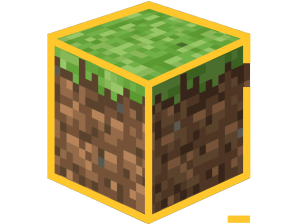My country, your country – Public showcase events
Following the weeks after the conclusion of the “My country, your country” project, the students had the unique opportunity to present their work in two major events, the E-TECH Portugal Technology Fair and the PaRK International School Tech Fair.
E-TECH Portugal is one of the country’s biggest technology fairs, where students from schools all around the nation get together to showcase their classroom projects and get in touch with the latest trends and technologies related to education. The Minepark members were invited to present their work and talk about what they had learned during this activity, as well as the challenges they faced and the ways they worked together to achieve their goals. Needless to say, we were all honored to be invited to such an important event.
PaRK IS Tech Fair is an annual school event where students invite their parents and present to the whole school community their classroom projects that involved technology integration. It is a whole-day event filled with extraordinary and inspirational presentations of student-created projects ranging from robotics and programming to handcraft and design.
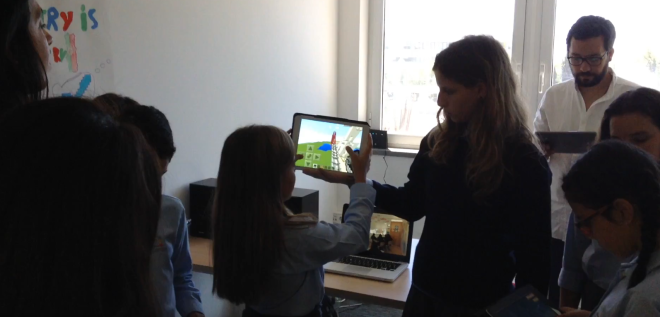
The Minepark project was also featured at the GMS/Apple in Education event, where teachers were invited to get acquainted with the current educational technologies available from Apple. The “My country, your country” project was a perfect fit for this conference, as it showed not only how Minecraft was implemented in a school’s curriculum but also how the iPad was used as the principal platform for accessing the game world as well as the multiplayer server.

The above events as well as the project itself helped us to think of Minecraft and the impact it can have as an educational platform in a deeper and broader sense. It is obvious by now that Minecraft is much more than just placing and removing blocks in a 3d world, but also involves interdisciplinary learning and the cultivation of important soft skills. Through the Minepark project we have successfully included disciplines like Geography (terrain, biomes, regions and maps), History (research, accurate historical data, culture and national heritage), English (command use, user interface and peer communication), Engineering and Architecture (3D orientation and physics). All these knowledge combined helped students fine-tune their 21st century skills, project planning, computational thinking and complex problem solving skills as well as team management and task distribution skills. And if that wasn’t enough, Microsoft had announced a new version of Minecraft called Minecraft: Education Edition, which would eventually include new tools and features specifically designed for teachers and classroom environments. Fortunately, we were lucky enough to experiment this platform prior to release and it is simply extraordinary.

The best is yet to come!
My country, your country – The last weeks
It has been exactly half a year since our last Minepark update. The end of a school year combined with the beginning of a new one and summer holidays in between can really interfere with a teacher’s schedule. For these reasons, this week’s update will be compiling the last weeks of the project into one post.
Spoiler alert: its going to be quite a long post.
Week 10:
During this week’s gathering we received two new visitors that got to spend some time with us and the project. Neuza Pedro, professor at the Institute of Education at Lisbon University, and Sílvia Couvaneiro, PhD student at the same establishment. Both are researchers studying how technology is used and integrated inside a classroom environment, so the school invited them to have a look at what our students have been accomplishing through the Minepark project. Needless to say, the students were very excited to receive visitors and very eager to show their work to them.
Regarding the warp issues that we experienced the week before, they were finally resolved because our server was now equipped with a new teleportation plugin called SimpleWarp. This plugin made teleportation inside the world much faster and more stable, although all warp points had to be created from scratch. Important note about this plugin: the warp points had to be created and opened through a command in order for them to be available to all students.
With the warps in place the students managed to travel to the location of their projects without problems, although not all of them. Unfortunately Minecraft PE received an update a couple of hours before our activity, which in turn prevented some students from accessing the server because their game client had updated automatically. Nevertheless, these students got to join their peers with access to the server and worked together.
In Lisbon, the Padrão dos Descobrimentos was now in its last stages of completion, while up high the Serra de Estrela mountaintop the students placed a snowy biome, appropriate to the region’s weather characteristics.


Between Lisbon and Porto a group of students initiated a new project, the University of Coimbra, Coimbra’s most famous monument. Moreover, the Alentejo biome was given the most attention so far in order to replace the grass blocks with sandstone.


One thing that the students themselves noticed was that since the new warps plugin they couldn’t use the /tp command anymore, for whatever reason. This command used to allow one user to teleport directly next to another user inside the world. A small price to pay for having a new, better and functioning teleportation plugin.
Week 11:
The last minute Minecraft PE update from last week had us searching for and configuring a new server version. Fortunately this time, it didn’t take long before we had a working server up and running. This new version, game and server, brought a couple of new additions to the project and the experience in general. The UI (user interface) and player menus were now more organised and included even more blocks, items and tools for the students to use. In addition, new commands for OPs were added to the mix that allowed for activating status effects on players and even changing the weather.
Status effects have been around for a while in Minecraft and are obtained through food, potions and beacons. They can be placed on a player or any other entity and can be either helpful or harmful. What they do is alter the way the game is played or experienced, so for example a Speed effect will make a player run faster, a Haste effect will make a player break blocks faster etc. However, most of these status effects are not functioning inside a custom Minecraft world because mainly they are already there, especially in Creative mode. Some effects though do work, and can be really fun to use on others, especially when the commands for applying these effects are only available to the OP. These “fun” effects include applying nausea to a player (screen becomes wobbly), invisibility (user disappears from sight but can still interact with the world) or even blindness (screen becomes extremely foggy and view is limited). As expected, as soon as the OP started applying random effects to random students chaos took over for some time until they realised that someone was messing around with their gameplay, creating a playful atmosphere inside the classroom.
As for the weather commands, the OP could now change the weather at any time just by using simple commands. Types of weather included sunny, clear, rain or thunder, each one with its one characteristics, sound and visual effects. Controlling the weather in this way gave us the opportunity to see our world in different weather conditions, and as a result we managed to take some really unique and interesting in-game pictures. Moreover, the sunset was fine tuned and upgraded with a new color palete, clouds and visual effects, which in turn created some stunning views of our world that we simply had to capture as screenshots.
Back to the building projects, the University of Coimbra was now completed, although in the end it did not look much like the real one. The group responsible for this project suggested that they had to first create a model of a university before they actually start building the real thing, so that they could understand what type of material they should work with. Nevertheless, the project still resulted in an amazing construction.
In another twist of creativity and imagination, some students suggested that they should try and work on their projects during the night, so that they could add the necessary lighting effect to their current and existing projects. This was something that never came up before and we thought of it as an amazing opportunity to try and work under different conditions. It was only a matter of introducing a simple /timeset command to the world and everyone could work under the dim lights of their own creations, or add light wherever necessary.
In Lisbon, two new projects were being developed by two different teams, both of them classified as UNESCO World Heritage sites. The first was the magnificent Jerónimos Monastery or Hieronymites Monastery, what is probably considered the most iconic Portuguese monument.
The second one, and equally important, was the Belém Tower or Tower of St. Vincent, situated very close to the Jerónimos Monastery. Both of these monuments played a significant role in the Portuguese maritime discoveries of the Age of Discoveries.
To the north of Lisbon another important Portuguese monastery was being constructed, the Batalha Monastery, literally the Monastery of Battle.

It was completely obvious by now that students had the skills and talent to embrace any given or chosen project and re-create it in Minecraft. All of the constructions that took place in our world so far were real locations that students had the opportunity to research and study first through photos before moving into the building phase. However, at some point during this week’s activity one group had a different suggestion. They asked if they could work on something unique and personal, something that doesn’t necessarily exist in the real world, a project that they could be as creative and expressive as they wanted to be. This suggestion, although a bit abstract, gave us an amazing idea for a new project. For obvious reasons we couldn’t start building anything we wanted to build because of the objective of the whole project itself, but we definitely could channel this creativity into a new project.
The idea was that everyone were free to build their own house inside the Minecraft world. We decided that the best way to do this was to create a small village in the area of Alentejo (the region with less buildings and monuments) were everyone could build their dream house as they pleased. However, there was one condition: each and every house had to respect the architecture and design of the traditional houses found all over Portugal. The students were free to choose any type of traditional Portuguese architecture and adapt it to their personal architectural plans. We suggested to them that a good place to start their research was Portugal dos Pequenitos, a theme park situated in the city of Coimbra that consists of diminutive versions of Portuguese houses and monuments.
Needless to say, the students were extremely excited that they were given the opportunity to work and create something completely original that they could call their own, and the results were nothing less than spectacular.
In a matter of minutes houses, palaces, miniature castles and mansions began to rise from the ground, all of them unique and at the same time familiar to everyone. Color, design and architecture all came together to create a amazing little town in the middle of Alentejo that included the most iconic and representative creations of the whole world. Most importantly, the students got to express their creativity in a fun and engaging way, while learning so much in the process.
Week 12:
Because of school field trips, this week’s Minecraft activities were limited to only thirty minutes. Since there wasn’t enough time to initiate the server and resume last week’s projects we decided to do something different this time. The students were asked to present their personal worlds, the ones they work on during their free time at home with their friends. Students only had two minutes at their disposal to present their worlds, which in turn obliged them to focus on the important parts of their work and showcase their favorite projects or simply the ones they were most proud of. This activity resulted in an amazing collaborative presentation of personal projects made by our students, ranging from parkour portal maps to dream houses to self-sustaining roasted chicken farms (yes, this is a thing in Minecraft apparently).
This short gathering ended up being one of the best we’ve had since the start of this whole project. The students loved presenting their work and their audience vibrated with excitement each time someone showed something they didn’t know it was possible to do in the game. For the students presenting (since this was a voluntary activity) it was a great exercise in talking to the public and trying to figure out how and what to present in only two minutes. In general, it was the perfect way to take advantage of the thirty minutes we had at our disposal.
Week 13:
Minecraft PE update 14.3 brought some interesting changes to the game, especially with the way Minecraft deals with weather and light effects. Light sources, night time, sunrise and sunset received a graphics boost that was immediately obvious during the respective times of the day, which in turn allowed us to take some stunning pictures of our world.
While most groups were working on their existing projects, like the Jerónimos Monastery in Lisbon, one group decided to initiate yet another new project and begin construction on the Santa Luzia Sanctuary located in the northernmost district of Portugal.
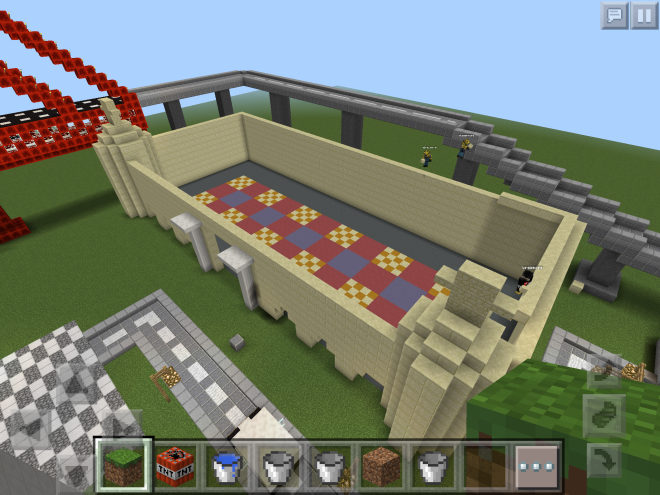

One group however decided to take things even further. After completing the Batalha Monastery in the North, the students responsible for it were curious to know a bit more about this magnificent monument, since none of them had ever visited it. By themselves, they decided to research a bit more about the monument and they discovered that the monastery had also served as the burial church of the 15th-century Aviz dynasty of Portuguese royals. Further research by the students revealed the location of the tombs as well as the names and reign period of the kings and queens that were part of this dynasty. The students then, by their own initiative, decided to recreate this burial ground and place the names of the royal family members and the time they reigned on wooden signs in front of every tomb. When questioned about their motives for doing this they answered that putting down all this information concerning the dynasty not only helped them to learn all these names and dates but also served as an attraction for the other students to visit and learn a bit more about their project.
This event was by far the most impactful of the Minepark project so far, because it clearly showed that students, when given the right tools, they can take control of their own learning and advance even further than expected, looking to satisfy their curiosity and finding innovative ways to promote and cultivate their learning.
Week 14:
All good things must eventually come to an end. We started this week’s activities with a heavy heart knowing that this was going to be the last time we access and work in our world. On the other hand, the students were extremely motivated to try and conclude all pending projects so that everything was in place. Even more so when they were informed that the following week they were invited to present their project to the biggest technology fair of the nation, E-TECH Portugal.
The students didn’t want to lose any time and they realized that they had to work all together in order to have things ready for the fair. First, they decided to finish replacing the Alentejo biome with the sandstone block, so that the region could finally look and feel like it does in real life. Although most of the replacement process took place in the previous weeks, it took them less than five minutes to have the entire region ready.
The students then moved to Lisbon, where they all helped conclude the monuments there, primarily focusing on the Jerónimos Monastery, both inside and outside.
Some finishing touches were also added to the rest of the monuments of the capital, including the addition of the Portuguese “calçada” surrounding the buildings, a traditional-style pavement used for many pedestrian areas in Portugal.
With the activity coming to an end, the students decided to visit their world one last time and take group photos in front of their creations.
The end of the class coincided with the end of the day inside our Minecraft world. The students knew that the time had come to look back one last time and say goodbye to this amazing project, this digital creation that went far beyond our expectations. We all knew that we worked hard to build all this and everyone understood that it only became possible because of group work, collaboration and communication between everyone involved. What we achieved was extraordinary and what we learned on the way about each other and ourselves was and will remain priceless. We couldn’t be more proud.

My country, your country – Week 9
One of Minecraft’s greatest features is the constant update and upgrade of the game and its tools coming directly from the developers working at Mojang. These updates keep the game always fresh and introduce new ways to interact with the world and the other players. Our students are always super excited when even the simplest of updates arrives because they know that something will work better, in a different and unique way. That is why they usually update the game as soon as a newer version is available (some of them even have the game configured to automatically update whenever possible).
On the other hand, this makes our work as server administrators that much more complicated because the server has to always correspond with the game’s version in order to be playable. Until now it was enough to update the .phar file of the server with the latest version (Phar being the archive file used to distribute our application) and the server would be playable. But just like Minecraft, Pocketmine has come a long way too, and in order for Pocketmine to accompany all the features offered by the game it had to receive a complete overhaul. At some point during the last week Minecraft PE received an update so important that Pocketmine could not accompany anymore using the current PHP5 protocol (PHP being the scripting language used to communicate with the web servers) and had to be updated to the latest PHP7 version. This new protocol would eventually make the server much more stable and make available all the tools and features of the original game to the users. But for this to happen we had to reinstall Pocketmine, re-configure the server properties and update all existing plugins, which in turn had us searching for compatible versions of our plugins all over the internet and the forums. Eventually we were able to get everything working with the latest version (with new warp points, since the previous ones were deleted from the update) and after testing the server it was obvious that the whole system was much more stable and stronger, with the world rendering faster and smoother.
Unfortunately the EssentialsTP plugin that allowed users to warp to different points, even though it was working for the OP, it was not available for use by the students, This meant that for the time being they had to travel from one area to the other on foot, and we had to arrange for a new one as soon as possible. Nevertheless, even without fast travel options, the students still managed to produce a lot of work.
In Sagres, the southwest point of our world, the lighthouse was completed and it was observed during nightfall to see how it worked.


The Alentejo area was expanded significantly with the help of the new students, now reaching Sagres and all the way up to Lisbon.

In Lisbon, the 25 of April bridge was connected to the highways leading to the city and beyond, while to the east of the capital a mountain was being raised.


Although the students did manage to work very well this week, it became obvious that the ability to warp around the world is a very important one, making the search for a functioning plugin a priority for next week.
My country, your country – Week 8
It has been almost a month since our last update, mainly because of the two-weeks Easter Holidays break as well as some other school events that took place during our gathering. Nevertheless, the students were back refreshed, rested and ready to continue with their massive task of completing Portugal inside Minecraft PE.
This week marked the beginning of the third period of lessons based on the annual school cycle, for this reason we had some students leaving the group to participate in other My Time activities, as well as new students eager to join our group and begin collaborating with their peers on this epic mission. The new students were given login names and were explained the fundamentals of our project, the basic rules and principles we defined in the beginning of the project and joined groups of experienced students in order to guide them and help them become oriented inside the world. Needless to say, these new students were discussing and building projects in no time since all of them already had experience with Minecraft PE.
One of the first tasks the new students had to participate in, with the help of some of the experienced ones that had no projects pending, was to help with the replacement of the Alentejo biome, from grass to sandstone. In a matter of minutes the group was already working on very large area of the map, adding to the work done in previous weeks.

Closer to the southern beaches of Faro, some of the newer students had the idea of building a parking lot next to the entrance to the beach and place cars and camping cars in it, as if visitors and tourists had just arrived.

In addition, the A2 highway connecting Alentejo with Faro was completed, one of the many highways that students were constructing at the time.

To the west of Faro a new warp point was added, marking the location of Sagres, the extreme southwest point of continental Europe. There, one student decided to initiate construction on the Lighthouse of Ponta de Sagres, an iconic building of the region.

Near the center of the country, work on the Pena National Palace was completed, as well as the IC19 highway connecting Sintra with the North.
Another very important milestone was the completion of the 25 of April Bridge in Lisbon, including its highway, lower train tracks and top suspension wires.

With the conclusion of the above grandiose projects, two new ones were launched in the same region. The first was the Batalha Monastery, one of the most important gothic sites in Portugal. The second one, considered to be the most difficult and ambitious of all projects, was the Serra de Estrela mountain range found in the east of the country. As mentioned in previous posts, mountains are some of the most difficult constructions to undertake in Minecraft because of their size and shape. In order to make the mountains look as natural as possible, this particular group decided to construct massive rectangular shapes out of earth blocks so that later on they could start removing layers of them in a diagonal direction.


The arrival of new students to our project brought a new wave of enthusiasm, ideas and motivation to the whole group, as it is clear from the creations above.
My country, your country – Week 7
During this week’s Minecraft activities we had the honor of receiving a very special visitor into our classroom. Mrs. Susana Felício, Innovative Educator Expert and Teacher Engagement Manager Support for Microsoft Portugal, joined our group for a couple of hours and got to meet the students behind this fantastic project. Mrs. Susana was kind enough to spend some time with the children while they got to show some of the projects they were working on at the time inside our world, as well as their own personal projects that they develop during their free time. Needless to say, the students were thrilled to have someone from outside the school visiting and checking out their work, especially someone that works in Microsoft, the company that since 2014 owns the intellectual rights to Minecraft.
Work advanced as usual during the classroom activity in all major regions of the country. In the city of Porto a group of students started and completed the Clérigos Church, a Baroque monument famous for its tall bell tower.

In Lisbon, the Padrão dos Descobrimentos and Pena National Palace were slowly becoming a (virtual) reality, while the 25 of April Bridge could now support traffic on top of its suspended, double lane roads.
All over the world roads were being constructed to connect the various cities and regions. Highway IC19 was placed to connect Lisbon and Sintra with the North, while the A2 highway was extended all the way down to the sandy beaches of the South.
Finally, a new warp point was added to our server representing the city of Castelo Branco. There, a group of students took the initiative and began constructing the Castelo Branco Castle, the city’s most famous national monument.

Week 7 marked the last week of activities for the second term and the students were advised that work on the world would resume three weeks later, because of the Easter Holidays break. A well deserved one considering all the amazing creations that the students managed to make in just seven weeks.
My country, your country – Week 6
Lag. The bane of modern online gaming.
By definition, lag is a noticeable delay between the action of players and the reaction of the server in a video game. This can be caused by high latency or insufficient processing power from the source. In our case, lag was a way the server was letting us know that the version we were running was not stable, thus making gameplay and even login impossible.
At first we thought that the server was lagging because of the water blocks placed in the south of the world to create the ocean. Since water blocks actually contain movement and physics, we kind of assumed that too many of them could eventually slow down the server to a point that it becomes unresponsive. So we asked for only a handful of students to login to the server (since all of them at the same time was totally impossible) and remove all the water blocks placed in the ocean, in the hopes of recovering some of the memory we needed to all login and resume work.

Unfortunately that did not solve the lag problem not even a bit, which meant that we had to urgently search for an updated stable version of a PocketMine server. After an hour of research we finally had a new version installed, better and more stable than any other version we had so far. This was immediately noticed by everyone because the world now would render in a transition effect, just like it did in the very first version of the server six weeks ago. Needless to say, this stability gave the students a massive boost of confidence and enthusiasm and everyone were back to building in no time.
The Castle of Guimarães was completed and the group responsible for it moved straight on to new projects. It was now standing proud as the first monument a player would find when visiting the North.

In Lisbon, a group of students began building the city’s most recognizable construction, the 25 of April Bridge, that connects the capital to the municipality of Almada on the left bank of the Tejo river. Another group decided that it was important to start connecting all the cities and regions with highways, adding another layer of realism to the world.

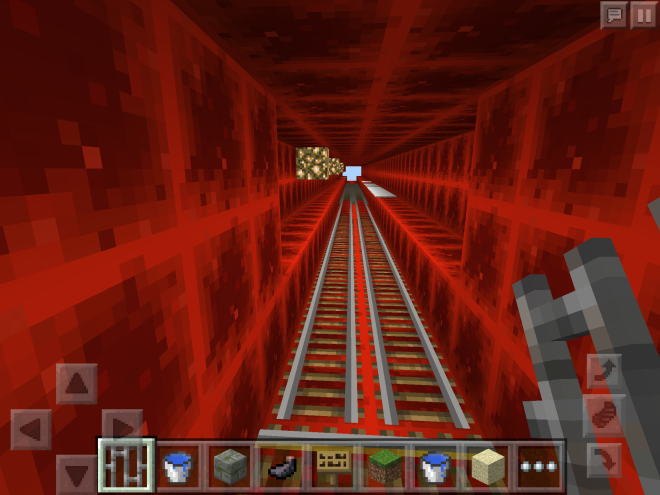

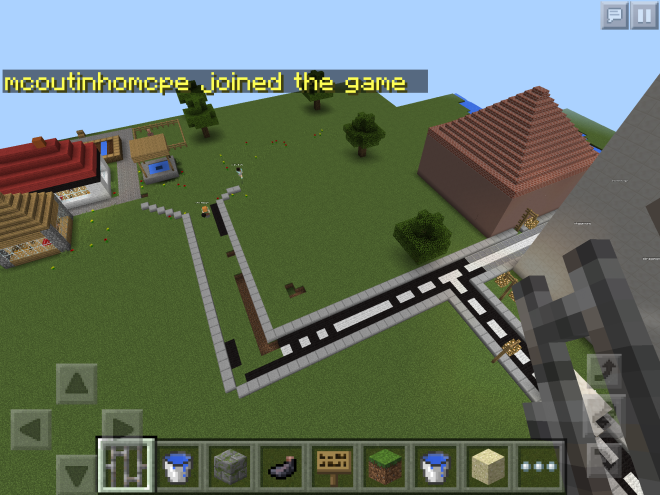
One of the many advantages that the latest server version brought to our world is the ability to render the world in a very long distance. This made it possible for us to take beautiful aerial pictures of the map, as well as enjoy the view from a higher area point.
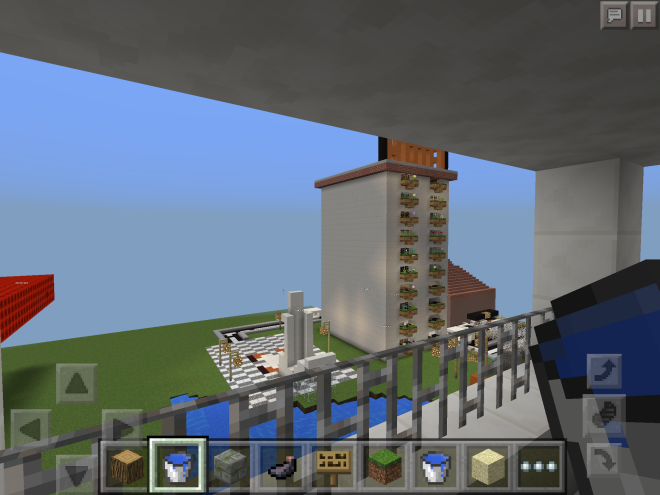
For the first time in three weeks we were able to conclude our work and feel confident that our server could handle it without any issues. Week 7 could not come soon enough!
My country, your country – Week 5
Another week, another Minecraft PE update, which meant that we had to update the server as well. Fortunately this time we were better prepared and anticipated the update, so that by the time the students had to get together and work again everything was working as normal.
This time around, the update fixed some of the some of the texture bugs created by the last one, although it did make the server rendering more slow. The world would now render in area blocks and not in its usual transition effect, a small price to pay for having the server up to date and running again.
Up in the north a group of students began constructing one of the most iconic castles of the country, the Castle of Guimarães. This castle is the principal medieval castle in the northern region, also known as the birthplace of Portugal.
Just a little outside Lisbon, another group decided to start building what is considered to be the most iconic palace of Portugal, the Pena National Palace. It stands on the top of a hill in the Sintra Mountains above the town of Sintra and can be easily recognized by its warm exterior colors.
Finally, inside the capital city the Cristo Rei Sanctuary was completed, while in the southern region of the country an entire ocean was being created next to the sandy beach.


Some time before the end of this week’s activity the server became very slow and almost unresponsive. Students had to logout and login again various times in order to continue their work, while others simply could not login back again. Most probably this had something to do with the server updates, and hopefully it will eventually get fixed by next week’s gathering with a new or updated server version. Fingers crossed.
My country, your country – Week 4
Just like last week and every other week before that, students were supposed to simply tap the server inside the Minecraft PE app and enter their world. Only this time the app returned an error saying that the server is down and must be updated to the game’s latest version in order to work. We were all caught by surprise and nearly panicked because first, we did not know how to actually update the server and second, there was no guarantee that the world would remain intact after the update.
At some point during the past week Minecraft PE received an update from the App Store. These updates are quite often (every two to four weeks) and usually aim at fixing in-game bugs and introducing new tools to the game experience. From the time when we were setting up the server by following the instructions available at the PocketMine forums, not once did we encounter any info concerning the server update or how do game updates can alter the save files. One big disadvantage of PocketMine being an open-source software is the fact that instructions and solutions to problems are scattered all over the forums, in the form of questions or comments, and can be quite difficult to find what you are looking for, especially when looking for specific files. Fortunately, by doing a simple search in Google, we were able to find a Youtube video explaining how to upgrade PocketMine to the latest version, which included clear instructions as well as the installation files themselves in the description. In less than thirty minutes we had the newest version installed and the server up and running, but not before backing up the previous server version just in case things went wrong.
Finally, the students were able to join the server again without any problems and resume their work. Unfortunately, because of the update some minor visual bugs appeared inside the game, mainly in the texture and skins of some block types. That being said, it was not anything serious and could be easily fixed by replacing the broken blocks with new ones.
Lesson learned. Always keep the server updated to the same version as Minecraft PE.
As for work, up north a group of students went back to building the waterfall situated in the Geres National Park. Mountains and waterfalls are some of the most challenging projects a user can undertake, because they have to be made of gradually smaller layers of randomly placed blocks, or else they end up looking like pyramids. Nevertheless, our mountainous waterfall was starting to look more and more like a real one and less like a waterpark slide. In addition, traditional stone granaries, typical of the area, started appearing close to the bank of the Douro River.


The Alentejo area was expanded even more and new structures were added to it.

One student decided to add a new area to the world, a small city situated in the center of Portugal called Évora.

Castles are quite the usual site in Portugal. They come in various sizes and can be found in almost every city (and almost every village too). One small group of students decided to build a standard castle in a small village situated between Porto and Lisbon, so that they can understand what goes behind the construction process and eventually try and build one of the more famous, real-life castles.
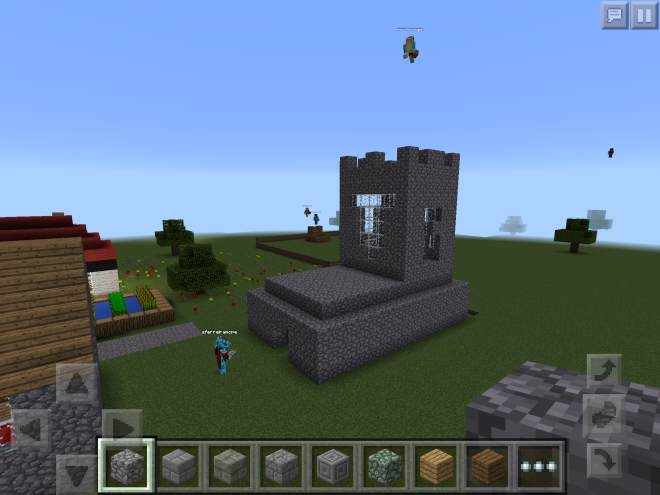
Back in the capital things were looking very promising. The “Fado” traditional restaurant together with “Mine” Hotel were completed, and a boat was added in Tagus River. On the other side of the river one group began building one of the most recognizable monuments of Lisbon, the Cristo Rei Sanctuary.


Even though the students had less time to work because of the server issues in the beginning, they still managed to conclude some of their unfinished projects and initiate new ones.
My country, your country – Week 3
By week three everyone knew the routine. Come to class, enter the server, join your workgroup, resume building. After the first interaction with the world map, students had a whole week to think and investigate on what they would like to work one, either a monument, a building or a biome. Most came back with new and fresh ideas while others continued where they had left last time. By now everyone where more comfortable with the whole project and were working faster and more efficiently, as seen from the photos below.
In the north of the country Dom Luís I bridge was concluded, while new elements were added to the biome.


The desert biome, also known as Alentejo, was expanded even more. Being the largest biome of them all, it is also the one that involves most of the manual work, since every single ‘grass’ block needs to be replaced with a ‘desert’ one.



In the south of the map, some students got together and began working on the beach biome, with some interesting ideas to accompany their creations.
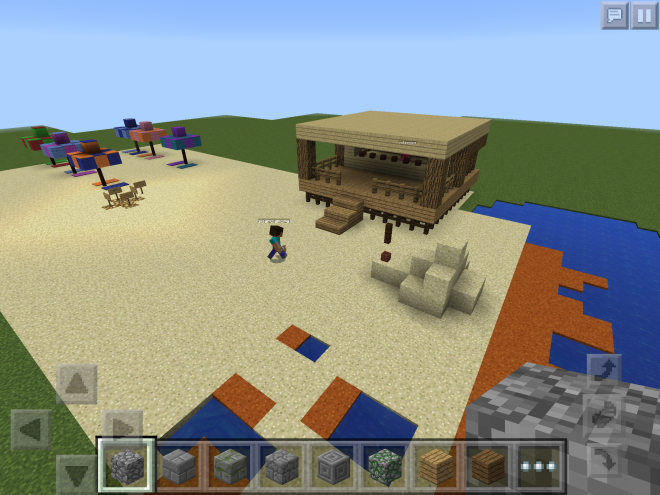

Everyone would agree that the most ambitious area of the world is Lisbon, the capital city itself. To give this area an urban look and feel, some students started by building a hotel and a restaurant. A second group decided to initiate construction on one of the most famous Portuguese monuments, the Padrão dos Descobrimentos, situated on the bank of the Tagus River, which was previously added by the same group.

In less than two hours, we had all of the biomes of the world in some stage of development, while Lisbon was slowly taking shape.
